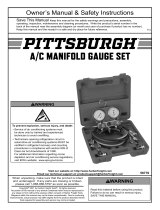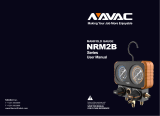Pittsburgh Automotive Item 62707 Owner's manual
- Type
- Owner's manual
Pittsburgh Automotive Item 62707 is a manifold gauge set for automotive air conditioning systems. It has the following features:
- Measures high and low-pressure side pressures
- Allows for refrigerant recovery, evacuation, and charging
- Has sight glass to check refrigerant appearance
- Comes with quick disconnect valves for easy connection and disconnection
- For use with R-134a refrigerant only
This gauge set is ideal for servicing automotive air conditioning systems. It is easy to use and provides accurate readings.
Pittsburgh Automotive Item 62707 is a manifold gauge set for automotive air conditioning systems. It has the following features:
- Measures high and low-pressure side pressures
- Allows for refrigerant recovery, evacuation, and charging
- Has sight glass to check refrigerant appearance
- Comes with quick disconnect valves for easy connection and disconnection
- For use with R-134a refrigerant only
This gauge set is ideal for servicing automotive air conditioning systems. It is easy to use and provides accurate readings.












-
 1
1
-
 2
2
-
 3
3
-
 4
4
-
 5
5
-
 6
6
-
 7
7
-
 8
8
-
 9
9
-
 10
10
-
 11
11
-
 12
12
Pittsburgh Automotive Item 62707 Owner's manual
- Type
- Owner's manual
Pittsburgh Automotive Item 62707 is a manifold gauge set for automotive air conditioning systems. It has the following features:
- Measures high and low-pressure side pressures
- Allows for refrigerant recovery, evacuation, and charging
- Has sight glass to check refrigerant appearance
- Comes with quick disconnect valves for easy connection and disconnection
- For use with R-134a refrigerant only
This gauge set is ideal for servicing automotive air conditioning systems. It is easy to use and provides accurate readings.
Ask a question and I''ll find the answer in the document
Finding information in a document is now easier with AI
Related papers
-
Pittsburgh Automotive Item 60806 Owner's manual
-
Pittsburgh Automotive 62622 Owner's manual
-
Pittsburgh Automotive Item 62637 Owner's manual
-
Pittsburgh Automotive Item 63391-UPC 193175358622 Owner's manual
-
Pittsburgh Automotive Item 60806 Quick start guide
-
Pittsburgh Automotive Item 94681-UPC 193175321527 Owner's manual
-
Pittsburgh Automotive 63273 Owner's manual
-
Pittsburgh Automotive Item 62788 Owner's manual
Other documents
-
 Pittsburgh A/C MANIFOLO GAUGE SET Operating instructions
Pittsburgh A/C MANIFOLO GAUGE SET Operating instructions
-
Harbor Freight Tools Quick_Connect Compression Tester User manual
-
MasterCool 85510-YF Operating instructions
-
MasterCool 85512-YF Operating instructions
-
Harbor Freight Tools R134A User manual
-
Harbor Freight Tools R134A Quick start guide
-
Snap-On Dual 3412 User manual
-
Harbor Freight Tools 100 lb. Dual Tank Abrasive Blaster User manual
-
 NAVAC NRM2B0201 User guide
NAVAC NRM2B0201 User guide
-
MasterCool 99172 Operating instructions













